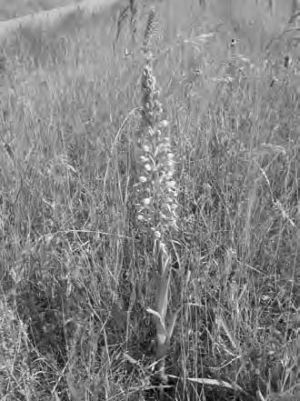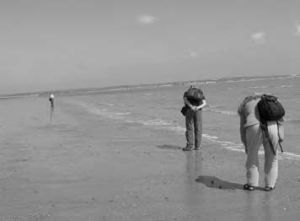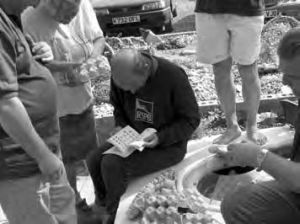|
A very enjoyable two-day field meeting led by Eric Philp and based on the Sandwich Bay Bird Observatory Trust field centre at TR 355575 was held on 5- 6 June 2004 in mostly brilliant weather. We met at the field centre from where we were very kindly driven by the field centre warden Kevin Thornton northwards to the old Princes Club House to start our field work. In tetrad 35P we found live Cochlicella acuta and Cernuella virgata at the top of the beach, while the shore yielded shells of Diodora graeca, Gibbula cineraria, Calliostoma zizyphinum, Tricolia pullus, Crepidula fornicata, Trivia arctica, Polinices catenus, Ocenebra erinacea, Nucella lapillus, Buccinum undatum, Neptunea antiqua, Hinia reticulata, Hinia incrassata, Oenopota rufa, Oenopota turricula, Antalis vulgaris, Nucula nitidosa, Nucula nucleus, Striarca lactea, Mytilus edulis, Ostrea edulis, Chlamys distorta, Chlamys varia, Pecten maximus, Aequipecten opercularis, Anomia ephippium, Parvicardium ovale, Cerastoderma edule, Mactra stultorum, Spisula elliptica, Spisula subtruncata, Ensis arcuatus, Angulus tenuis, Fabulina fabula, Macoma balthica, Donax vittatus, Circomphalus casina, Timoclea ovata, Corbula gibba, Pholas dactylus, Barnea candida, Zirfaea crispata and Sepia officinalis. Further up the coast in tetrad 36K we found live Cepaea hortensis just above the strand line among sea spurge Euphorbia paralias and sea holly Eryngium maritimum. The shells on the beach here were Diodora graeca, Crepidula fornicata, Ocenebra erinacea, Nucella lapillus, Buccinum undatum, Mytilus edulis (live), Ostrea edulis, Chlamys varia, Aequipecten opercularis, Laevicardium crassum, Cerastoderma edule, Ensis siliqua, Macoma balthica, Donax vittatus and Corbula gibba. Further inland we found live Cochlicella acuta, Cernuella virgata, Helix aspersa, Cepaea hortensis, Pupilla muscorum, Deroceras reticulatum, Cepaea nemoralis and Monacha cantiana and dead shells of Monacha cartusiana. One of the joys of this section of coastline was the impressive range of flowering plants on the stabilised dunes, the most memorable of these being the lizard orchid Himantoglossum hircinum and the bedstraw broomrape Orobanche caryophyllacea with its wonderful scent. In tetrad TR 36L we again found dead shells of Monacha cartusiana and live Cepaea nemoralis and Helix aspersa. The following morning we arrived at the bird observatory among excited conversation about large numbers of small elephants! This was among a group of members of the SBBOT examining the contents of a mercury vapour moth trap and pleased with the record number of Small Elephant Hawk-moths Deilephila porcellus that had been caught that night. This survey is part of a long term study of local and migrant moths being carried out at the field centre. The group had with them a recently published identification book which for the first time illustrates live moths at rest rather that dead pinned specimens, and were making very good use of it. We set out southwards this time and started by examining the shore in tetrad TR 35U, where we found shells of Gibbula cineraria, Crepidula fornicata, Trivia monacha [new], Ocenebra erinacea, Nucella lapillus, Hinia incrassata, Oenopota turricula, Antalis vulgaris, Nucula nucleus, Striarca lactea, Mytilus edulis, Chlamys varia, Aequipecten opercularis, Cerastoderma edule, Spisula elliptica, Moerella donacina [new], Macoma balthica, Donax vittatus, Timoclea ovata, Venerupis senegalensis [new], Mya sp., Barnea candida and Sepia officinalis. A ditch in tetrad TR 35T yielded the freshwater species Planorbis planorbis, Lymnaea truncatula and Bithynia tentaculata, while the New Cut in tetrad TR 35N contained Valvata piscinalis, Potamopyrgus antipodarum, Bithynia tentaculata, Bithynia leachii, Lymnaea stagnalis, Lymnaea peregra, Planorbis planorbis, Sphaerium corneum and Oxyloma pfeifferi. A ditch at Worth, also in tetrad TR 35N, had Potamopyrgus antipodarum, Bithynia tentaculata, Bithynia leachii, Lymnaea peregra, Planorbis planorbis, Ancylus fluviatilis and Sphaerium corneum. One rather worrying feature about the freshwater habitats at these sites was the extreme luxuriance of the water weeds in what one would have imagined to be an oligotrophic environment. This sort of thing is happening in other parts of the country and does not bode well for the survival of the more sensitive species of our native fauna and flora. Sampling of snails on water weeds in the freshwater habitats was greatly facilitated by the use of a 4-hook grapnel which Eric had made out of an old galvanised wire coat hanger and a length of sheet lead. I was so impressed by the performance of this simple device that I made one myself and used it to good effect a few weeks later to sample Willow Lake at Linch Hill in the Windrush valley near Witney, Oxfordshire. Other species found in square TR 35N were Zonitoides nitidus and Deroceras reticulatum. We would like to express our thanks to Kevin Thornton and members of the SBBOT for facilitating the meeting and for making members of the Conchological Society most welcome at the field centre. |

Fig 1. Eric Philp and REH grab sampling stream
Fig 2. Brandy bottles Nuphar luteum.
Fig 3. Lizard orchid Himantoglossum hircinum Fig 4. REH and Peter Topley
Fig 5. Recorders at the moth trap at the Bird Observatory
Fig 6. Bedstraw broomrape |
Field meeting at Sandwich Bay, Kent 5-6 June 2004
Issue
8
Page
3





